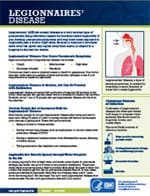Legionella bacteria are found naturally in freshwater environments, such as lakes and streams, and also soil. The bacteria can become a health concern when they grow and spread in human-made building water systems. Legionnaires’ disease is a serious type of pneumonia (lung infection) caused by Legionella bacteria. People can get sick when they breathe in small droplets of water or accidently swallow water containing Legionella into the lungs. There is little to no evidence of person-to-person transmission of Legionnaires’ disease.
 Health Impact of Legionella
Health Impact of Legionella
Legionella can cause Legionnaires’ disease. Legionnaires' disease is similar to other types of pneumonia (lung infection) and often results in hospitalization, with symptoms that include:
- Cough
- Shortness of breath
- Fever
- Muscle aches
- Headaches
- Vomiting
|
If you develop pneumonia symptoms, see a healthcare provider right away. People at increased risk for developing Legionnaires' disease include:
|
Impact of Legionella on Plumbing Systems
Biofilm is often associated with Legionella in plumbing systems. Biofilm is a slimy coating that is formed as microbes attach to underwater surfaces (e.g., the inside of a pipe). Biofilm can form in valves, fittings, and on pipe walls, feeding Legionella.
Legionella overgrowth can also be caused by plumbing system replacement and repairs, water temperatures between 68°-122°F, water pressure drops, water main breaks, water stagnation, and increased sediment.
Preventing Legionella at Home
The Centers for Disease Control and Prevention has created a guide with steps to take to protect yourself from Legionella and other waterborne illnesses.
You can prevent Legionella growth through regular maintenance, including:
- Cleaning showerheads and faucet aerators on a regular basis
- Flush the hot water tank on regular basis using a qualified plumber unless you can safely do it yourself
- Keeping your water heater at 140°F
Note: Scalding is a risk at this temperature. Do not use a high-temperature setting if the house is occupied by children or others who may open a hot water faucet unaware of the risk of scalding. To reduce the risk of scalding, the temperature of the water leaving the showerhead or faucet should be no higher than 122°
Stagnant water also promotes Legionella overgrowth. If you have been gone for a week, run all hot and cold water taps for at least two minutes at a low to medium flow (without splashing if you are immunocompromised) and flush all toilets.
You should also run all hot and cold water taps at least once a week for at least two minutes at a low to medium flow (without splashing if you are immunocompromised) in rooms that are not frequently used, such as guest bathrooms, and flush toilets that are not frequently used. And run your taps after a boil water notice, which can cause stagnant water.
Plumbing repair work can also loosen biofilm, releasing Legionella bacteria. After plumbing repairs, run hot and cold water for at least five minutes at taps close to where the repairs were made.
Consider other possible sources of Legionella at home such as hot tubs, CPAP machines, decorative fountains, etc. Be sure to follow manufacturer recommendations for maintenance and cleaning in order to avoid Legionella overgrowth.
- Additional Resources

